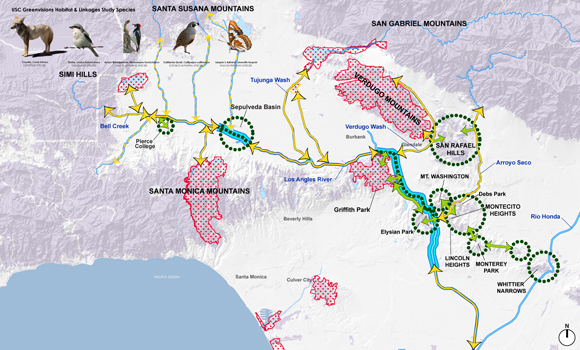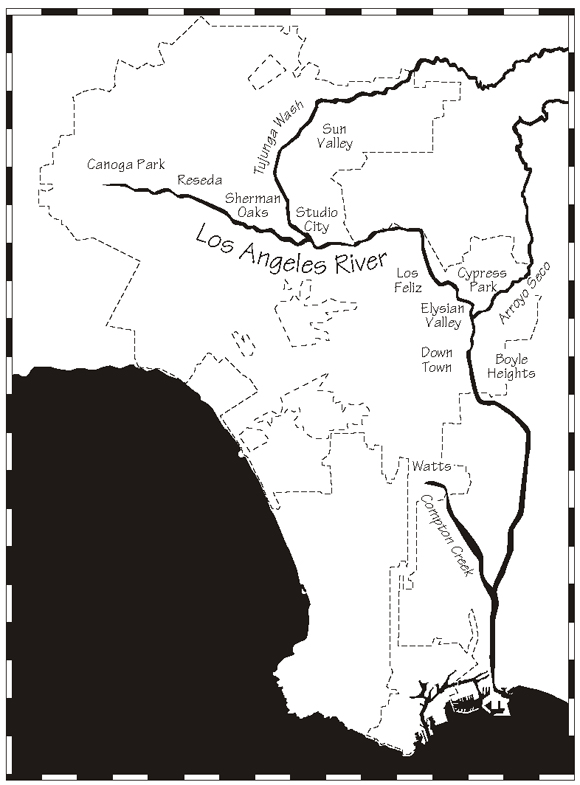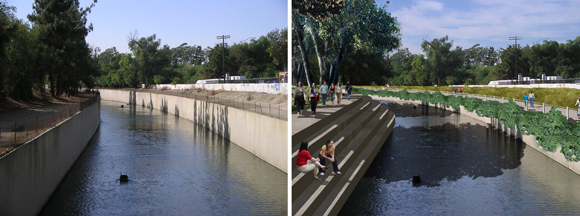
The Los Angeles River is a seasonal stream that runs from Canoga Park in the San Fernando Valley, east and southward through Los Angeles and Burbank and Glendale in its northern reaches, and then heads southward, flowing through Vernon, Commerce, Maywood, Bell, Bell Gardens, South Gate, Lynwood, and finally into the harbor at Long Beach. By the time the City finished confining it to a concrete straightjacket in the 1930s, it almost squeezed the life—and especially the wildlife—out of the river. But in an age of heightened green awareness, L.A. is now counting on the River to revitalize the city.
Signs of hope are hard for Californians to find in the recession new year of 2010. But the Los Angeles River restoration effort and its Revitalization Master Plan are proof that legacy projects can persevere. The River was rediscovered as a potential ecosystem and recreational resource by the poet Lewis MacAdams and the Friends of the L.A. River (FOLAR) in the 1980s. Today, the Los Angeles River has become a touchstone for creative urban design and the inspiration for a more sustainable Los Angeles. The L.A. River Master Plan, adopted in 2007, takes full advantage of the River’s potential to supply greater open space and recreation opportunities, bring communities together, and upgrade the ecological integrity of the River Basin.
The L.A. River Master Plan proposes an entirely new system of governance, under a new super agency, the Los Angeles River Authority; a new level of entrepreneurial leadership under the Los Angeles River Revitalization Commission; and a new standard of river oriented philanthropy in the form of a Los Angeles River Foundation. The Plan allows for measures that will lessen peak storm flow, allowing for some greening of the concrete river channel itself. As Burnham’s plan was to Chicago in its scope and vision, so is the L.A. River plan to Los Angeles.
John Chase: Is the most important aspect of the L.A. River effort more open space, is it improvements in the ecology of the river basin? Better storm water management? Is it greater recreational opportunity, or is it giving people a more palpable connection to nature?
Deborah Weintraub: There are near- and long-term goals. The long-term goal is to bring back ecological value to the River. That’s a more challenging goal because of storm water. Near-term, it’s a 32-mile linear park in the heart of the city—something we can implement that will make a huge difference in the life of the city.
Chase: How do you restore a system that originally involved lots of open space but is now confined to a fraction of its former area?
Weintraub: We are not going to be able to restore the L.A. River flood plain to its original state. People live in it!
Carol Armstrong: We are not restoring an ecological system, we are restoring ecological value to the post-industrial landscape. If we can do it here in L.A., it’s also important to many other urban places, particularly in the developing world, that are urbanizing rapidly.
Weintraub: I want to emphasize that nothing we are talking about doing along the river will jeopardize flood protection. When people say just rip out all the concrete, the answer is, well, that’s not possible, but it is possible to take it out in selected areas. It is possible to do some armored channel bottoms with plants that might get scraped out when we have floods. We are essentially still going to need an armored river, because the river has been reduced to this narrow channel only one sixth as wide as it once was. The speed with which the water goes through there is now much greater. It’s devastating to plant and animal life. If we were just to unpave the river, nothing would survive.

Chase: Is the L.A. River a single project undertaken by a single entity, or is it a family of overlapping projects undertaken by multiple entities?
Weintraub: It’s definitely a family, because of the overlapping responsibilities among the different agencies—the City, the Corps of Engineers, the Water Board, Flood Control, and others. And that is its strength, because it is a cooperative effort. We have been working with the County, with the DWP (Department of Water and Power), because they are also interested in water recycling and cleaning more water sources locally. If we can attenuate some of that storm flow, capture it, and use some of it for water supply, it helps those agencies accomplish their goals, and it also helps the River.
Chase: Do you ever see a downtown Los Angeles with rail tracks underground and open space immediately along the river? Is it possible that the banks of the L.A. River east of downtown might one day be the same kind of living room for the city, heart of the city, that Central Park is for Manhattan?
Weintraub: Generally speaking, the master plan says we want to move rail, consolidate it on one side of the park, and cover it where possible.
Chase: If you came to Los Angeles on a typical October day a hundred of years ago, would there have been cracked earth, or would there have been swampy areas?
Weintraub: The Glendale narrows, north of downtown, probably always had water. So did the Sepulveda basin. But there probably was very lit tle flow in the river at this time of the year. Now that we have a steady flow—because of year round urban irrigation runoff—there is a lot of discussion about preserving it, because it does provide habitat, particularly for shore birds.
Armstrong: Councilman Reyes and the national League of Cities have been working with the people in Washington, who are starting to understand that Southwestern rivers are different: the L.A. River shouldn’t be held to the same standards for clean water as Eastern rivers, because it is an ephemeral stream. It can be dry most of the year, and then torrents come down. As the Army Corps has reminded us, we accomplish the same slope from our mountains to the sea that the Mississippi River accomplishes in 2200 miles.
Chase: What do you say to the classic doubters who don’t believe the river can be transformed?
Armstrong: One thing we do is show them examples of other cities that have done remarkable things.
Weintraub: We have some sister city rivers in other communities. One of them is the Cheonggyechon River in Seoul, Korea. They had encased a stream; they had built a freeway over it. They went back and opened it up. They revitalized their entire downtown, totally changed it.
Chase: How much fear is there of the change along the River, of bringing in the public, who may not be used to seeing the River as a public place?
Armstrong: A lot. It’s been a forbidden place. However, in the places where they have already started to construct linear greenways and parks, the communities—even the ones that were hesitant—come to realize that it can be a great thing. I am thinking, for example, of the Tujunga Wash greenway project. A lot of the residents in that area did not want the project. But, now that it is there, they love it.
One of our greatest challenges is working with the County and the Corps in developing a way of patrolling the rivers that is more legible and understandable to the general public, because right now it’s quite confusing—which areas are forbidden and which ones are not. So, we are working on a River Master Use Agreement between the City, L.A. County Flood Control, and the Corps of Engineers.

Weintraub: That Master Use Agreement is revolutionary. It seems like a small thing, but our goal is a single organization that you can pick up the phone and call, which is responsible for maintaining all the greenways on the river. Probably within a year we will be able to have that agreement.
Chase: What is the realistic expectation of returning wildlife, birds, fish, and animals to the city along the river?
Armstrong: It’s only going to get better. They are already here. There are fish in the L.A. River now—and people who fish in the L.A. River—but the fish are non-native species. The steelhead trout is a native species that is an indicator species; a lot of people think that the river will have been truly revitalized if they reappear. Again, we are not going to be able to restore the ecosystem of the L.A. River, but we will be able to restore ecological value.
Learn more at the L.A. River Revitalization website, www.lariver.org, and at Friends of the L.A. River (FOLAR), folar.org.

John Leighton Chase, Assoc. AIA, Urban Designer for the City of West Hollywood and Chair of the arcCA Editorial Board, interviews Deborah Weintraub, AIA, Los Angeles Chief Deputy City Engineer, and Carol S. Armstrong, PhD, Project Manager for the Los Angeles River Revitalization Master Plan.
Originally published 4th quarter 2009 in arcCA 09.4, “Infrastructure.”





